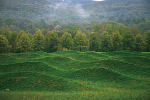 Home
Home
Oppenheim and Schafer, Discrete-Time Signal Processing ISBN 0-13-198842-5.
Prentice Hall, Upper Saddle River, NJ 07458. © 2010 Pearson Education, Inc.
MATLAB is the software tool of choice for learning and doing DSP. There have been many fine tutorial introductions to MATLAB written. The approach taken here is to use some of The Mathworks (http://www.mathworks.com/) tutorials to get a general introduction to MATLAB, its command environment, editor, etc. and then learn many specific techniques by recreating many of the figures in the text.
The Mathworks site lists several tutorials for learning MATLAB. The Interactive MATLAB Tutorial (http://www.mathworks.com/academia/student_center/tutorials/mltutorial_launchpad.html) matches well with what we are doing here. The follow table lists the various parts of the tutorial and notes which are most important to do.
|
Time |
Link |
Description |
Importance |
|
(5:38) |
Directions for viewing modules and downloading the tutorial example files. |
Yes |
|
|
(6:10) |
Get comfortable with the MATLAB desktop environment |
Yes |
|
|
(22:55) |
Learn to use MATLAB as a powerful tool for solving problems and visualizing functions |
Very |
|
|
(2:13) |
Explore a case study of using MATLAB to solve problems |
Yes |
|
|
(13:06) |
Work with data in MATLAB – how to bring it in and manipulate it |
Not much |
|
|
(10:55) |
Better understand complex mathematical functions and data by visualizing it with MATLAB |
Very |
|
|
(12:33) |
Analyze data through MATLAB functions and computation |
Not Much |
|
|
(6:42) |
Model your data to an equation and interpolate upon it in MATLAB |
Not Much |
|
|
(9:29) |
Write your first MATLAB program (script M-file) |
Yes |
|
|
(8:01) |
Communicate your work by publishing it as an HTML report, all from within MATLAB |
Some |
If time permits, do all the tutorials above. If you can’t do them all, at least do the important and very important ones. These will give you the background needed for the next section.
Now that you have seen some of the basics of MATLAB you can start using MATLAB to learn more DSP. Our approach is to take several of the figures in the book and recreate them with MATLAB. In doing so you will learn more about MATLAB and more about the signal processing behind the figures. Each of the Build-a-Figures is only a page or two and should take only 30 to 60 minutes to complete.
Click on the Build-a-Figure tab to see all the build-a-figures.
Do the Build-a-Figures for chapter 2 in order, then you should be able to do any of the other Build-a-Figures, and the MATLAB Projects.
 Home
Home
Oppenheim and Schafer, Discrete-Time Signal Processing ISBN 0-13-198842-5.
Prentice Hall, Upper Saddle River, NJ 07458.
© 2010 Pearson Education, Inc.